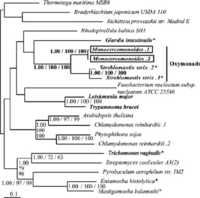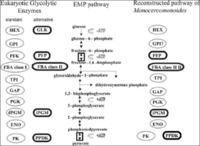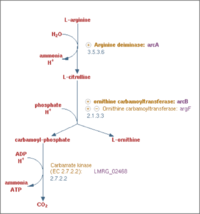Monocercomonoides
Written and Edited by Sheldon Carpenter, Meagan Olive, Matt Cronin and Anthony Belo
1. Classification
Higher Order Taxa
Domain: Eukarya (1)
Phylum: Metamonada (1)
Class: Anaeromonadea (2)
Order: Oxymonadida (2)
Family
Family: Polymastigidae (2)
Genus: Monocercomonoides
2. Description and significance
The microbial eukaryote genus Monocercomonoides is a type of oxymonad characterized as the first eukaryote genus to lack any mitochondrial genes and all key proteins responsible for mitochondria function (1). Species within the genus have been discovered living in the intestinal region of small mammals and insects (1,3). The current hypothesis for the species’ ability to survive without mitochondria is due to its habitat and a sulfur mobilization system acquired from bacteria (1). Some of the genus’s closest relatives include the taxa Trichomonas vaginalis, Giardia intestinalis and Spironucleus salmonicida, all of which contain genes coding for mitochondrion-related organelles, implying that the loss of mitochondria in Monocercomonoides was a secondary adaptation rather than a distant evolutionary divergence from mitochondria-containing eukaryotes (1). This genus is significant because it challenges the previous notion of mitochondria inclusion being a requirement for eukaryotic life (1).
3. Genome structure
Monocercomonoides is a unique genus of eukaryotic microorganisms because of its complete lack of mitochondria or any mitochondrion-related organelles (MROs). This observation is confirmed by the Monocercomonoides genome. Homology searches reveal that Monocercomonoides lacks genes encoding for mitochondrial import machinery, metabolite transport proteins, and iron-sulfur clusters (1). Furthermore, searches for specific N-terminal and C-terminal sequences reveal an absence of targeted import genes and genes coding for mitochondrial membrane proteins (1). This evidence, along with the following comparison of the Monocercomonoides genome to that of related organisms, can be used to deduce how this genus evolved without mitochondria.
The genome of Monocercomonoides strain PA203 from Chinchilla laniger was sequenced in 2005 in order to phylogenetically align eight protein-coding sequences and the 18S rRNA sequence of different oxymonads (2). Comparisons of genes coding for 𝛼-tubulin, 𝛽-tubulin, 𝛾-tubulin, EF-1𝛼, EF-2, cytHSP70, ubiquitin, 18S rRNA, and HSP90 favor the placement of oxymonads near Trichomonas and diplomonads, specifically with Monocercomonoides and Streblomastix sharing a branch within the oxymonad group (Figure 1). Two of the genes in this study, coding for 𝛼-tubulin and 𝛽-tubulin, favor an alternate placement of Monocercomonoides on the plant-chromist segment of the tree (2). However, due to the fact that this placement is not well-supported by other morphological and physiological studies, and that it is only favored by two genes out of nine, one can conclude that the close relationship of oxymonads to Trichomonas and diplomonads is much more likely. This inconsistency is most likely a result of horizontal gene transfer from plant-chromist organisms (2).
Further evidence of the divergence of Monocercomonoides due to horizontal gene transfer lies in the uniqueness of its metabolic processes as compared to those of related species. Monocercomonoides, unlike all other eukaryotes, lacks mitochondria, or any mitochondrion-related organelles (MROs). Not all relatives of Monocercomonoides use mitochondria for energy acquisition; some utilize hydrogenosomes, a MRO (4), and some simply use the Iron-Sulfur Cluster (ISC) pathway to obtain energy (1). Alternatively, Monocercomonoides utilizes a sulfur utilization (SUF) system common in bacteria. A close relative, Primastix, also uses this SUF system, but it is paired with a mitochondrial homolog, while Monocercomonoides lacks any evidence of mitochondrial genes (1). Based on this information, it can be concluded that Monocercomonoides’ and Primastix’s acquisition of the SUF system was not evolved, but rather attained via bacterial horizontal gene transfer. This SUF system was sufficient for energy production, leading to the secondary loss of a mitochondrial homolog in Monocercomonoides (1).
4. Cell structure
Monocercomonoides has a total of 4 whip-like structures used for movement known as flagella anchored to their cellular membrane with modified centrioles known as basal bodies (3). The flagella are grouped in pairs on opposite sides of the cell and each is longer than the entirety of the cells ovoid body (Figure 2) (3). As with all oxymonads, Monocercomonoides has a single long contractible appendage that originates from the bases of a flagellum known as an axostyle. The axostyle is connected to the first basal body by a sheet of microtubules referred to as the preaxostyle (3). Monocercomonoides also has two basal body anchors known as microtubular roots and each is associated with one pair of the two basal body pairs. Monocercomonoides is the only oxymonad genus known to have microtubular roots (3). Electron microscopic imaging of Monocercomonoides has found that the intracellular morphology lack any Golgi apparatus, mitochondria or potential homologs of the two structures (5).
5. Metabolic processes
Like all eukaryotes, Monocercomonoides carries out glycolysis as part of its metabolism (6,7). Since Monocercomonoides lacks any mitochondria or mitochondrion-related organelles (MROs), each molecule of glucose catabolized results in a yield of relatively fewer ATP when compared to eukaryotes that can engage the TCA cycle and electron transport chain (3). To account for this, Monocercomonoides has adapted several alternative glycolytic enzymes that aid in energy conservation. The four enzymes that differ from those found in the typical eukaryotic glycolytic pathway include pyrophosphate-fructose-6-phosphate phosphotransferase, fructose-bisphosphate aldolase class II, 2,3-bisphosphoglycerate independent phosphoglycerate mutase, and pyruvate phosphate dikinase. These are commonly abbreviated as PFP, FBA class II, iPGM, and PPDK, respectively (Figure 3). A fifth alternative enzyme, an alternative to glucose-6-phosphate isomerase (GPI), is suspected to play a role early in the glycolytic pathway but has yet to be confirmed (7).
The addition of PPDK to the conversion of phosphoenolpyruvate to pyruvate (typically catalyzed solely by pyruvate kinase) has a robust effect on ATP conservation. In this altered pathway, PPDK is expressed at much higher levels and allows for greater ATP conservation and regulation of glycolysis when compared to pyruvate kinase. This is due to PPDK’s reversible nature and use of inorganic phosphate where pyruvate kinase only catalyzes the forward reaction (7). As in typical glycolysis, co-factors are reduced in order to oxidize substrates for ATP production (6). In order to regain the oxidative power necessary for energy production, Monocercomonoides makes use of anaerobic fermentation, using pyruvate:ferredoxin oxidoreductase (PFOR) to re-oxidize these co-factors and form ethanol and acetic acid as byproducts (1,7). Re-oxidation of co-factors is also carried out by [FeFe]-hydrogenase, yielding hydrogen gas (7).
Along with adjusted glycolysis, Monocercomonoides utilizes a complete arginine deiminase/degradation pathway (Figure 4) similar to those found in Giardia intestinalis and Trichomonas vaginalis (3,1,8). The arginine degradation pathway produces eight times more ATP than glycolysis in Giardia intestinalis (7,11). This same output is expected in Monocercomonoides but has yet to be fully confirmed (1,7). Adoption of this pathway allows Monocercomonoides to use an alternative energy pathway in addition to glycolysis, increasing the overall ATP yield necessary to function in the absence of mitochondria or MROs.
In the absence of any mitochondria or MROs, Monocercomonoides makes use of an Iron-Sulfur Cluster assembly mechanism previously unseen in eukaryotes (1). Iron-Sulfur Clusters (ISC) are prosthetic groups essential to almost all life forms and participate in several functions including enzyme activity, electron transport, and regulation of gene expression (9,10). Thought to be a ubiquitous pathway in all eukaryotes, Monocercomonoides is novel in that it lacks all genes encoding for typical eukaryotic ISC formation (1). Monocercomonoides instead performs de novo ISC formation through the use of a multi-subunit sulfur assimilation (SUF) system. Components of this system have no mitochondrial signaling pathways and instead act solely in the cytoplasm. Monocercomonoides’ SUF system retains all major catalytic sites on the SUF subunits seen previously in prokaryotes while exhibiting a fused SufS and SufU subunit, a feature unique to Monocercomonoides alone (1,12).
6. Ecology
Monocercomonoides sp. is generally found within the intestinal tracts of vertebrates (13). Being a member of the oxymonad group, Monocercomonoides sp. is identified as an obligate animal symbiont, often residing within insects, amphibia, reptiles, and some mammals (14). While generally considered the “powerhouse” of the cell, mitochondria have little to do with energy production within organisms that live in environments with little to no oxygen presence (15). Research has shown a presence of Monocercomonoides on both the eastern and western hemispheres, however there has not been significant evidence indicating the affect environmental conditions may have on the presence of the microorganism. To date, mitosomes, another MRO, within Giardia, Entamoeba, and Microsporidia have been identified as the closest form of mitochondrial reduction in microorganisms other than Monocercomonoides sp.. The reduction of mitochondria has been associated with an anaerobic environment, in which alternative methods of metabolism must be present (1).
7. Pathology
Monocercomonoides has not been documented as having pathogenic traits.
8. Current Research
Current research aims to determine the presence of mitochondrial components in the absence of a true mitochondrion in Monocercomonoides. Basic marker proteins normally present within reduced mitochondrial pathways were also found to be absent within the genome of Monocercomonoides sp. (1). It is the current belief among researchers that the pathway is absent altogether and has been replaced by a bacterial cytosolic sulfur mobilization system (1). Future experiments may seek identification of the exact metabolic pathway for Monocercomonoides sp. using a comparison of both prokaryotic and eukaryotic components.
9. References
(1) Karnkowska, A., et. al. 2016. A eukaryote without a mitochondrial organelle. Current Biology 26: 1274-1284.
(2) Hampl, V., Horner, D., Dyal, P., Kulda, J., Flegr, J., Foster, P., and Embley, T. 2005. Interference of the phylogenetic position of oxymonads based on nine genes: Support for metamonada and excavata. Mol. Bio. Evol. 22: 2508-2518.
(3)Simpson, A. G. B., Radek, R., Dacks, J. B., and O’Kelly, C. J. 2002. How oxymonads lost their groove: An ultrastructural comparison of Monocercomonoides and excavate taxa. Journal of Eukaryotic Microbiology 49: 239-248.
(4) Embley, T. M., van der Giezen, M., Horner, D. S., Dyal, P. L., Bell, S., and Foster, P. G. 2003. Hydrogenosomes, mitochondria and earlier eukaryotic evolution. PubMed 55: 387-395.
(5) Brugerolle, G., Silva-Neto, I.D., Pellens, R., and Grandcolas, P. 2003. Electron microscopic identification of the intestinal protozoan flagellates of the xylophagous cockroach Parasphaeria boleiriana from Brazil. Parasitology Research 90: 249-256.
(6) Giezen, M. 2011. Mitochondria and the rise of eukaryotes. Bioscience 61: 594-601.
(7) Liapounova, N. A., Hampl, V., Gordon, P. M., Sensen, C.W., Gedamu, L., and Dacks, J.B. 2006. Reconstructing the mosaic glycolytic pathway of the anaerobic eukaryote Monocercomonoides. Eukaryotic Cell 5: 2138-2146.
(8) Schofield, P., Edwards, M., Matthew, J., and Wilson, J. 1992. The pathway of arginine catabolism in Giardia intestinalis. Molecular and Biochemical Parasitology 51: 29-36.
(9) Bandyopadhyay, S., Chandramouli, K., and Johnson, M. 2008. Iron-Sulfur cluster biosynthesis. Biochemical society transactions 36: 1112-1119.
(10) Johnson, D., Dean, D., Smith, A., and Johnson, M. 2005. Structure, function, and formation of biological iron-sulfur clusters. Annual review of biochemistry 74: 247-281.
(11) Zuniga, M., Perez, G., Gonzalez-Candelas, G. 2002. Evolution of arginine deiminase (ADI) pathway genes. Molecular Phylogenetic and Evolution 25: 429-444.
(12) Stairs, C., et al. 2014. A SUF Fe-S Cluster Biogenesis System in the Mitochondrion-Related Organelles of the Anaerobic Protist Pygsuia. Current Biology 24: 1176-1186.
(13) Botkin-Kowaki. 2016. Missing Mitochondria: Strange eukaryotic cell lacks ‘powerhouse’. Christian Science Monitor.
(14) Lauter, F. H. 1959. Haemoflagellates and intestinal flagellates from anura of Louisiana. Louisiana State University.
(15) Milius, S. 2016. Mitochondria go missing in microbe. Science News 189 (12): 14.
Written and Edited by Sheldon Carpenter, Meagan Olive, Matt Cronin and Anthony Belo, students of Jennifer Talbot for BI 311 General Microbiology, 2016, Boston University.




